Poisonous Plants for Dogs
Keeping Kilo the Pug Safe in the Garden
I recently read that there are hundreds of potentially poisonous plants for dogs.
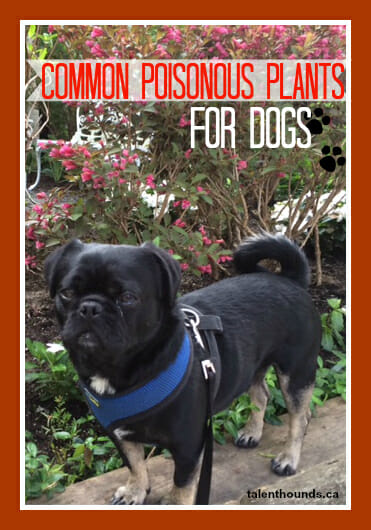
I am not a knowledgeable gardener by any stretch. However, I have been working with my husband on the little front garden in our new house over the last few weeks. I like a good mix of green and white plants, as well as lots of flowers for the bees to pollinate and to add color (plenty of pink).
I invest in perennials with a supplement of annual flowers. The front garden has quite a bit of shade because of some big old trees on the street, with a little bit of afternoon sun in some spots. The previous owners left some established perennials and shrubs. I added more euonymus, hostas, roses, peonies, begonias, lilies, geraniums and hydrangeas so far.
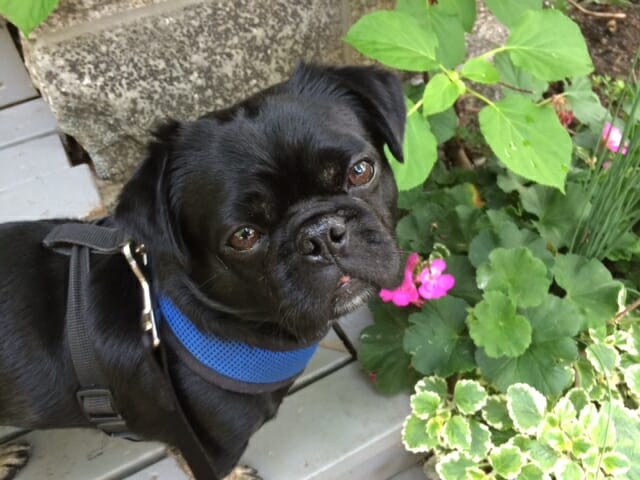
Kilo the Pug has been my little helper. The garden is open so he is on his leash, but he still occasionally gets his nose into things. My good friend in Minneapolis is also redoing her garden and just got a gorgeous new puppy- Buster. Given Kilo and the puppy both love to lick and chew, and we already had a nasty chocolate incident with Kilo, I decided to research on the ASPCA animal poison control site to see which common plants are the most dangerous. The results were overwhelming. I had no idea that stopping to smell or chew the plants could have so many hidden risks. I picked a few I know below to share.

List of common plants dangerous for dogs
(source: ASPCA)
Ivy
Also called English Ivy, branching ivy, glacier ivy, needlepoint ivy, sweetheart ivy and California ivy contains triterpenoid saponins that, if ingested, can result in vomiting, abdominal pain, hypersalivation, and diarrhea. Ivy is very common in our neighborhood, but Kilo has not shown much interest in eating it. We won’t be planting any.
Hostas
Hostas seemed innocent enough, but I was disappointed to read that the Saponins from Hostas may cause vomiting, diarrhea, depression. I kept them and Kilo shows no interest.
Tomato Plant
I was very surprised to find that most parts of the tomato plant are poisonous to animals. Ingesting tomato plant leaves, vines or stems is unlikely to be deadly, but symptoms may include weakness, unusual drooling, vomiting, diarrhea, paralysis. We usually plant a few tomatoes, but I think we’ll skip them this year or put them up the back, well out of Kilo’s reach.
Tulip/Narcissus and Daffodil Bulbs
The bulb portions contain toxins that can cause intense gastrointestinal irritation, drooling, loss of appetite, depression of the central nervous system, convulsions and cardiac abnormalities in dogs and cats. As Kilo loves to dig up then chew things, we avoided bulbs this year.
Azalea/Rhododendron
Members of the Rhododendron spp. contain substances known as grayantoxins, which can produce vomiting, drooling, diarrhea, weakness and depression of the central nervous system in animals. Severe azalea poisoning could ultimately lead to coma and death from cardiovascular collapse. We have one someone gave me that lives up high indoors then moves out of reach outdoors in our back yard.
Geranium
I planted some white and pink geranium as so hardy and good for flowers. I will have to watch Kilo.
Symptoms from eating may include vomiting, anorexia, depression, dermatitis.
Begonia
There are over 1,000 species and 10,000 hybrids and they are really common around here. I think I may have planted some of them. Apparently if eaten they can cause oral irritation, intense burning and irritation of mouth, tongue and lips, excessive drooling, vomiting, difficulty swallowing. I will have to watch Kilo closely near them.
Bishop’s Weed
I have plants that look like Bishop’s Weed. They may cause symptoms similar to Begonia’s.
Oleander
All parts of Nerium oleander are considered to be toxic, as they contain cardiac glycosides that have the potential to cause serious effects—including gastrointestinal tract irritation, abnormal heart function, hypothermia and even death.
Castor Bean
Apparently ornamental plants and pruned foliage are common sources of poisoning. The poisonous principle in Ricinus communis is ricin, a highly toxic protein that can produce severe abdominal pain, drooling, vomiting, diarrhea, excessive thirst, weakness and loss of appetite. Severe cases of poisoning can result in dehydration, muscle twitching, tremors, seizures, coma and death. I don’t think we have this one.
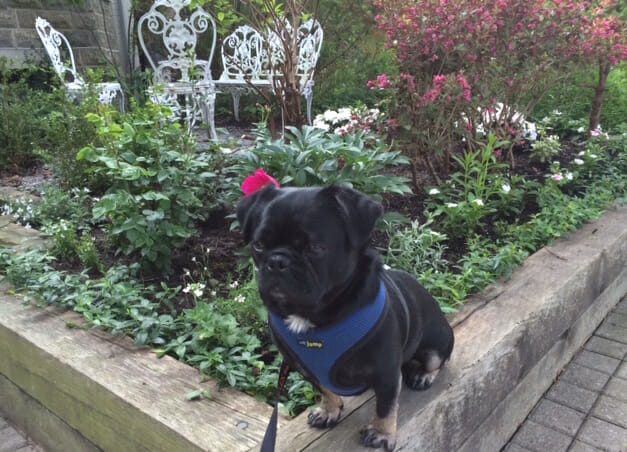
Cyclamen
Cylamen species contain cyclamine, but the highest concentration of this toxic component is typically located in the root portion of the plant. If consumed, Cylamen can produce significant gastrointestinal irritation, including intense vomiting. Fatalities have also been reported in some cases.
Kalanchoe
This plant contains components that can produce gastrointestinal irritation, as well as those that are toxic to the heart, and can seriously affect cardiac rhythm and rate.
Yew
Taxus spp. contains a toxic component known as taxine, which causes central nervous system effects such as trembling, incoordination and difficulty breathing. It can also cause significant gastrointestinal irritation and cardiac failure, which can result in death. Who knew.
Amaryllis
Amaryllis species contain toxins that can cause vomiting, depression, diarrhea, abdominal pain, hypersalivation, anorexia and tremors.
Autumn Crocus
Ingestion of Colchicum autumnale by pets can result in oral irritation, bloody vomiting, diarrhea, shock, multi-organ damage and bone marrow suppression. So pretty but so dangerous.
Chrysanthemum
These popular blooms are part of the Compositae family, which contain pyrethrins that may produce gastrointestinal upset, including drooling, vomiting and diarrhea, if eaten. In certain cases depression and loss of coordination may also develop if enough of any part of the plant is consumed.
Peace Lily (AKA Mauna Loa Peace Lily)
Spathiphyllum contains calcium oxalate crystals that can cause oral irritation, excessive drooling, vomiting, difficulty in swallowing and intense burning and irritation of the mouth, lips and tongue in pets who ingest.
Lilies, especially for Cat Lovers
Some Lilies can be bad for dogs but pet parents need to be aware of the potential dangers if cats ingest lily plants and lily bulbs. Ingesting the smallest amount of any part of the plant, especially the bulb, can lead to kidney failure and lily toxins can cause awful illness, even death. Signs include vomiting, loss of appetite, depression, and kidney failure. We have a few, but Kilo and the local cats have shown no interest so far.
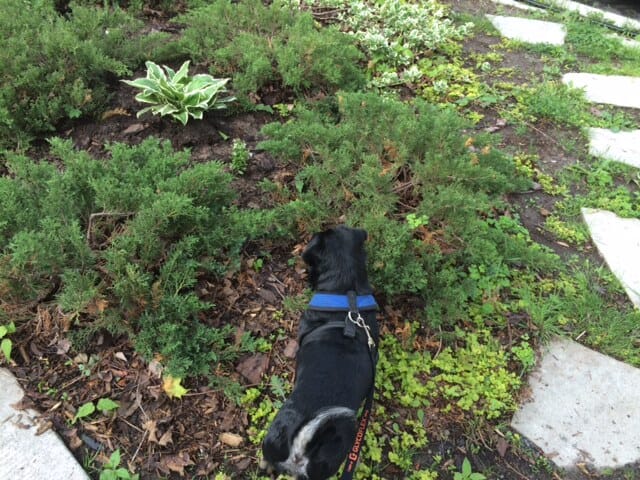
Insecticides and weed killers
You should also make sure your dog does not lick or swallow insecticides or weed killers on your own or other people’s lawns and plants. I do not use any, but I know one of my neighbors uses weed killer on his lawn so we avoid it, much to Kilo’s chagrin.
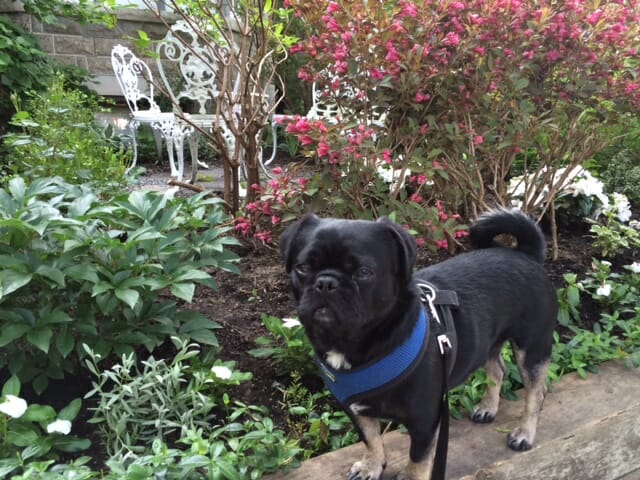
Signs of Poisoning
Going out in our neighborhood or garden now seems like crossing a minefield. Signs to watch for in cases of potential poisoning in dogs can be loss of appetite, vomiting, abnormal stool, irregular bodily functions, respiratory distress, balance issues, paralysis, weakness, and lethargy.
You should know what is normal, in order to know if something is not normal (as per Puppy advice from trainer Gillian Ridgeway).
An animal who has ingested anything toxic should be taken to the vet immediately. If you think that your dog is ill or may have ingested a poisonous substance, contact your local veterinarian or the 24-hour ASPCA emergency poison hotline directly at 1-888-426-4435 (fees may apply).
For another great article on Spring plants that could be harmful to animals check out Dogs Luv Us and We Luv Them. Cathy mentions several more plants I have near or in my garden including Boxwood and Privet Hedge.
The Humane Society also has information and a downloadable PDF

Yea, there are so many dangerous plants out there, it’s crazy!
ღ husky hugz ღ frum our pack at Love is being owned by a husky!
Wow, that is truly an overwhelming list of plants. Great post!
Yes it scared me. At least now I know a bit more about what to look out for and will supervise Kilo carefully near any plants. XS
That’s a long list of things! Mr. N dislikes eating vegetation of any sort so I don’t worry too much but our foster pup would stick anything in his mouth.
The full list has hundreds so I tried to narrow it down to plants I might choose. Kilo sniffs a lot but so far so good. He prefers treats or my fresh vegies and fruit. I watch him carefully.
Wow, there are so many plants that can hurt our pets. We have a certain low growing palm in our yard that my puppy loved to chew until a friend told me it was poisonous.
yes apparently small palms can be bad. I had no idea. Kilo played with the ones inside-not any more
It is overwhelming how many plants and flowers are toxic to dogs and cats. I made the same discovery when my cat Delilah started eating any flower that I brought into the house. I thought that I should look into that to be sure she wasn’t eating something harmful. Boy was I surprised when I found out that the majority of flowers that are found in bouquets at the store are toxic to cats! No more indoor flowers for us…
This is a handy list. we must keep our dogs safe
Thanks- the ASPCA have a really comprehensive list, but this one covers many of the more common plants. XS
Gosh, we used to have a lot of those in our previous yard. It IS overwhelming how many poisonous plants are out there. Luckily Rita is SO picky I know she’d never eat a plant. I can barely get her to eat most foods! 🙂 Hope lots of pet owners see this important info!
I actually had a dog who had poisoning due to a tree…it had little red berries that were very toxic. She ate one and ended up shutting down her GI tract. Fortunately, I saw her crunching the little berry and brought her in to the vet right away, and we were able to save her, but it was a very scary experience.
Oh no how awful. I’m so glad your dog was OK- how scary. We had to take Kilo straight to the vet when he stole chocolate- not a happy experience for any of us. I did see a red berry tree on the big list, but I didn’t see those trees around here. Maybe I’ll go back and see what it was. Thanks for stopping by.
Great list. Thanks for the info!
I knew about some of these, but had no idea about Hostas or tomato plans. Two such common plants that I bet most people do not know can harm pets. Great post.
Whaaat? Didn’t know about tomato plants..thankfully none of the dogs seem interested in them.
Great information…some of it surprising to most dog parents. It’s scary to think that some won’t pay any mind to any plant, and others will devour them all. Best to know your pooch, but always prepare for the unexpected.
I just can’t tell with Kilo so I watch everything. Nerve-wracking. Thanks for stopping by XS
Good to know! I hadn’t realized that about tomato plants, I hear the fruit itself isn’t good for them either. Stay safe, Kilo!
Great photos, very pretty and thank you for this extensive list!
I did a similar post last year on plants that are poisonous to pets and I was shocked at how many common plants can be poisonous to pets! Great post, thanks!
Love & Biscuits,
Dogs Luv Us and We Luv Them
I don’t think I was following then- I was oblivious as I only got Kilo after August and did not even register this danger last year. I’ll happily cross link if you would like? The more people that share the information the better I believe- I was quite upset by all the potential dangers. I’ll pop on your site and search and if you want to add my link to your older post it is probably evergreen. I’ll tweet out the 2. I’ll see if any other of our pals have a good post too. Thanks XS
That’s so weird about tomato plants since tomatoes themselves are fine!
This is oh so important and I am re-tweeting it now.
Thanks for sharing Carol XS
It has always amazed me how long the list of toxic plants for dogs and/or cats is. You would never even think twice about planting some of these if you didn’t see a list like this. Thanks for sharing! This could help a lot of dog owners as they garden.
Ok, first, Kilo is the cutest ever. Don’t tell Koly I said that.
Second, This makes me feel super grateful that neither of my dogs are plant eaters. The both grazer in the planter of wheat grass that I grow specifically for them, but that’s about it. I’m pinning this one though, since I’m always surprised how many people don’t know these plants are dangerous!
Yes- I am one of those. I knew a few of them but others not so much. Thanks!! (and Kilo the little rascal says thanks too) Susie
What a great list! I was also surprised by tomato plants, glad I’m able to share this with my humans!!! 🙂
This is a great list. We recently had a little scare because we didn’t realize that hostas were dangerous. I was so mad, like “why the hell do people plant these things EVERYWHERE if they are toxic!?”
I had no idea and my old garden was full of them. They are so attractive, hardy, easy and perennial – very popular around here. I have 3 or 4 in this garden and I think I will leave them, but I will not plant more as I had planned.
Excellent post – I never knew about many of those listed, especially the Azalea/Rhododendron. The side wall of our house is covered with them and Jax loves to run through and behind them when he’s playing. I will definitely be more observant when we’re out there. This is great for sharing and I shall.
I got a few surprises too, especially hostas and ivy. Thanks for popping by and sharing XS
thanks for sharing!